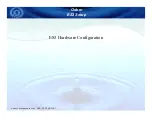
PIVOT-IR USER MANUAL
50
9-3 Temperature Correction
The accuracy of temperature conversion is also dependent on the physics of
the scene. These physical properties include emissivity and reflection of the
target, the transmission in the intervening atmosphere, and the background/
foreground temperature within the scene.
Make sure to select the correct temperature scale to assist with temperature
correction (see
8-14-1 Temperature Range).
9-5 Distance and Angle of Reflection
Although distance usually does not affect the temperatures measured by the
software it can be helpful to know the distance to the target location. Generally,
the further away the IR sensor is from the target/background area, the less
thermal contrast seen in the image.
Angles of reflection can also affect the contrast. This is significant because when
the IR sensor is operated at low angles over water there may be no perceived
thermal difference between the horizon and the water, i.e. the horizon can seem
to disappear. Users can change their angle by changing where they stand or by
attaching a camera to an unmanned aerial system.
While there is an input field for Distance there is not an input for Angle of
Reflection. Use the Comments section to create notes concerning positioning
and angles;
then, adjust the Distance setting according to
Section
8-14-4
Distance.
9-6 Humidity
Humidity remains in the atmosphere even on bright days. Water of all three
states can be found naturally in the atmosphere: liquid (rain, fog, and clouds),
solid (snowflakes, ice crystals), and gas (water vapor). Water in any state is
an obstacle to accurate temperature measurements. When the wave passes
through the water particles, a part of its energy is absorbed and a part is
scattered. Therefore the electromagnetic wave is attenuated.
The device does not account for humidity; make a note of any weather conditions
on a notepad before beginning the inspection.
9-4 Ambient Temperature
The ambient temperature, which is often referred to as the background, is the
temperature of the surfaces surrounding the imaged object. These surfaces are
those whose energy hits the face of the imaged object and reflect from it into
the camera’s field of view. Adjust the ambient temperature setting according to
Section
8-14-3 Ambient Temperature.




































